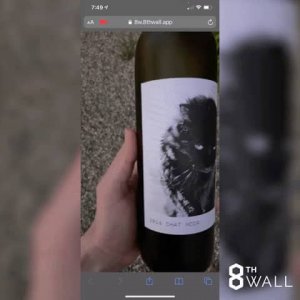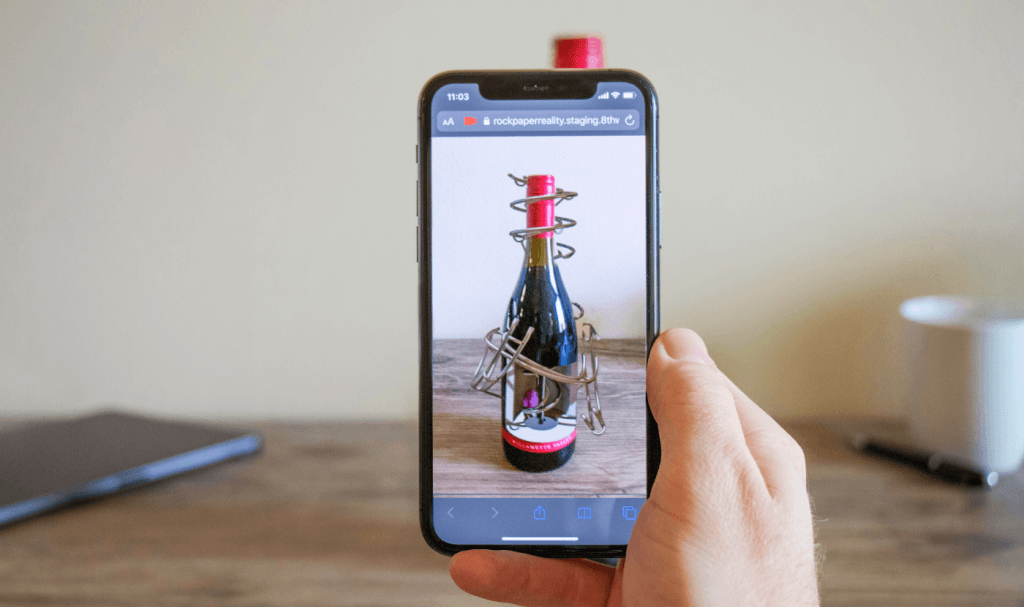The earliest AR experiences were based on physical markers like QR codes. As the technology developed, such targets were no longer necessary for many experiences. However, some experiences, particularly WebAR enabled branded packaging, are actually more immersive when based around a physical target.
While flat targets present a great deal of possibilities, the world isn’t flat.
“8th Wall is on a mission to make augmented reality for everyone, and to do that we need to be able to augment anything,” 8th Wall co-founder and CEO Erik Murphy-Chutorian said in a press release shared with ARPost.
To learn more, we talked with Murphy-Chutorian and 8th Wall’s Vice President of Product, Tom Emrich. Specifically, we talked about 8th Wall’s recently launched tool for creating Web-XR experiences from curved rather than flat targets, available now.
Curved Surfaces Are a Different Beast
WebAR is a variety of XR experience that is viewable without a dedicated app. In some cases, these experiences are launched from a phone’s camera but in others, they are viewable through browser windows. 8th Wall specializes in creating tools for both kinds of experiences.
 Some of these experiences require a target and others don’t. Those that do require targets are typically more interactive, particularly if the target is an unusual shape. We recently talked with 8th Wall regarding their tool for webAR face filters.
Some of these experiences require a target and others don’t. Those that do require targets are typically more interactive, particularly if the target is an unusual shape. We recently talked with 8th Wall regarding their tool for webAR face filters.
Just like creating experiences with flat targets is different from creating experiences that map to the topography of a person’s face, creating experiences for curved surfaces presents its own challenges and opportunities.
“With a flat surface, if you can see any of the image, you can see all of it. Curved surfaces self-occlude,” Murphy Chutorian explained in a video interview with ARPost.
The new 8th Wall tool allows for rapid prototyping and development, without the need for frequent measurement and label printing.
An experience like this has been in high demand from 8th Wall clients. Particularly, clients who are interested in what Emrich calls “brand-in-hand.”
The Potential in WebAR Connected Packaging
“AR really brings packaging to life and allows for the packaging or signing to tell a story,” said Emrich.
Many people initially experience XR through branded packaging and one of the largest industries to embrace WebARhas been the beverage industry. Naturally, the beverage industry is no stranger to curved surfaces.
Winemaker Siduri and XR design agency Rock Paper Reality created the first experience using 8th Wall’s new tool. This new experience uses the Siduri wine bottle as a scaffold for a winding rail, that a grape rides around and around the bottle.
The premier experience is natural as these three companies had worked together on another groundbreaking WebAR experience earlier this year, together with Microsoft Mixed Reality Capture Studios.
“8th Wall’s new technology helped Rock Paper Reality develop a frictionless augmented reality experience for Siduri wines, which lets their customers engage with their wine bottles like never before,” Rock Paper Reality CEO Patrick Johnson said in the release. “(…) The addition of curved image targets to 8th Wall’s platform opens up so many new use cases.”
The beverage industry comes to mind rather quickly, but in our interview, Emrich spoke of WebAR experiences launched from lipstick tubes, light posts, traffic cones, and more.

“That’s why we decided to call this feature ‘curved image targets’ rather than ‘can or bottle targets’,” Emrich explained. “We wanted the developer to think of how many curved surfaces are out there.”
The World Is Curved
Just like branded packaging isn’t limited to cans and bottles, the use cases for curved image targets aren’t limited to advertising. In an increasingly augmented world, this technology could be used for displaying wayfinding information, or schedules for road construction.
“This is like an entire new medium of expression,” said Emrich. “Think of how many things in your environment are shaped like a cylinder or a cone.”
So, be sure to keep an eye out for WebAR opportunities, coming to a curved surface near you.




